Decolonising the D'Arcy Thompson Zoology Museum
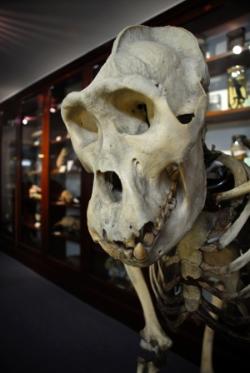 Like many natural history museums, our zoology collection was largely acquired during the colonial era of the late 19th and early 20th centuries. Specimens were acquired in India, Africa, Australia, New Zealand, Canada and other colonies and dominions of the British Empire as well as the colonies of other European countries.
Like many natural history museums, our zoology collection was largely acquired during the colonial era of the late 19th and early 20th centuries. Specimens were acquired in India, Africa, Australia, New Zealand, Canada and other colonies and dominions of the British Empire as well as the colonies of other European countries.
D’Arcy Thompson was definitely not a trophy hunter. He didn’t travel the world killing animals for his museum, but he acquired specimens from others who did. He also dealt with professional natural history dealers who may well have exploited developing countries in order to collect animals for profit. Some of the specimens in the museum are from species that are now extinct or endangered due to colonial activity.
As part of the museum’s commitment to inclusion and revealing forgotten aspects of the past, we are currently undertaking a decolonising exercise on the Zoology Museum, researching the stories behind the specimens to determine new ways of interpeting them. Some of the stories we uncover are shared here and we have also created new interpretation in the museum - book here to visit.
You can order a copy of the accompanying publication here.
We staged a special online event to discuss the project - watch the recording here.
Image right: Western Lowland Gorilla skeleton from the D'Arcy Thompson Zoology Museum, acquired by D'Arcy from William Cross of Liverpool in 1893.
View a virtual tour of the Nature of Empire exhibition
Buying for science – at what cost?
Natural history dealers in the 19th century
The origins of any museum’s acquisitions are multiple and the specimens collected by D’Arcy Thompson did not all come from the same source. Some came from expeditions, others were donated to the museum, but many were bought from particular sellers. In the late 19th century, it was not uncommon to find establishments in large western cities that imported wild animals alive to sell to menageries and zoos – and even museums, once the animals had died.
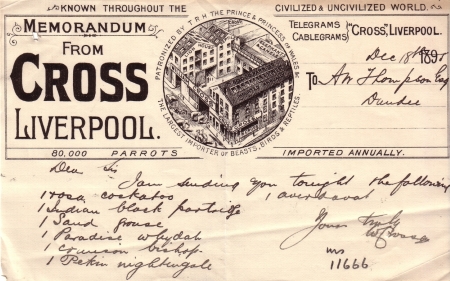 Such is the case of William Cross, a naturalist and importer of wild animals, owner of the “Cross Menagerie & Museum” in Liverpool. The company was based at the docks in order to be near shipping, encouraging the export of exotic species from faraway places. The Barton County Democrat newspaper of 16 December 1897 describes the business:
Such is the case of William Cross, a naturalist and importer of wild animals, owner of the “Cross Menagerie & Museum” in Liverpool. The company was based at the docks in order to be near shipping, encouraging the export of exotic species from faraway places. The Barton County Democrat newspaper of 16 December 1897 describes the business:
“Liverpool boasts one of the biggest wild beast emporiums - if not the biggest - in the world. It is the famous house of Cross. Mr William Cross, of Liverpool, is known at the ends of the earth. He always has some queer argosies on the sea consigned to him - perhaps a shipload of reptiles, a dozen elephants, or a few thousand parrots.”
Cross was indeed one of the most important and successful importers of animals, and he supplied these to zoos and private collections all over Britain, Europe and around the world. He employed his own hunters all over the globe to ensure a ready supply of some of the most exotic creatures. The colonial attitude of his business was made very explicit, proudly claiming in his letter-head to be “known throughout the civilized and uncivilized world”. D’Arcy Thompson obtained some of the museum’s most familiar specimens from Cross, including the gorilla skeleton and the mounted chimpanzee, both coming from Africa. One can only imagine the conditions in which each of these specimens was harvested by one of Cross's hunters.
Image above left: Letter to D'Arcy Thompson from William Cross, 1897 (courtesy of University of St Andrews Library Special Collections)
Hunted to Extinction - the story of the Huia Birds
One of the saddest stories in the museum is that of the Huia birds. Found only in New Zealand’s North Island, this majestic bird was extremely sacred to the Māori people. Huia feathers were worn in head-dresses and given as tokens of friendship and respect.
19th-century western biologists prized the huia for other reasons. It was the only known bird in the world in which the male and female differed radically in the size and shape of the bill (though as D’Arcy Thompson demonstrated, the mathematical curve is the same in both). Huia were already a vulnerable population in the 19th century because of habitat destruction caused by colonial settlers clearing large areas of forests. However, Victorian naturalists also played a part in the Huia’s downfall. Having identified the bird as a wonder of the scientific world, they started harvesting them in large numbers for overseas museums and collectors.
 In 1892 the New Zealand government declared it illegal to hunt the species, but did little to enforce the law. D’Arcy acquired his specimens from taxidermists Edward Gerrard & Sons in 1898, so they may well have acquired the birds illegally. Unfortunately, worse was to come.
In 1892 the New Zealand government declared it illegal to hunt the species, but did little to enforce the law. D’Arcy acquired his specimens from taxidermists Edward Gerrard & Sons in 1898, so they may well have acquired the birds illegally. Unfortunately, worse was to come.
In 1901, the Duke of York, heir to the British throne, visited New Zealand (then a British colony). During his visit, in Whakarewarewa, a high-ranking Māori woman took a Huia quill from her own hair and placed it in the Duke’s hatband. On his return home, Huia plumes quickly became a fashion craze and the birds were hunted to extinction within just a few years. The last reliable sighting of a living Huia bird was in 1907.
The Huia’s story is not unique – many species have suffered the same tragedy in the name of empire, fashion, trade and more. In a word, in the name of power.
Image right: Pair of Huia birds, acquired by D'Arcy Thompson from Edward Gerrard & Sons in 1898
Find out more about the Huia in this video by curator Matthew Jarron
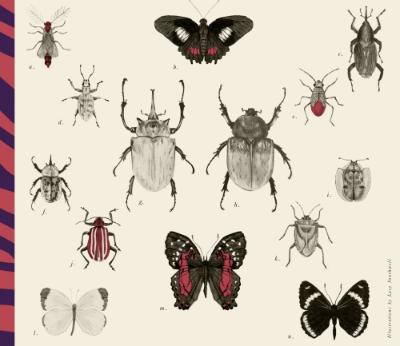 Insects from the West Indies
Insects from the West Indies
 Insects from the West Indies
Insects from the West IndiesD’Arcy’s museum benefitted from many individuals based in British colonies whose interest in natural history led them to build up their own private collections of specimens.
In 1892 D’Arcy reported receiving “a great number of West Indian insects from Mr A G Millar of Trinidad”. ‘West Indies’ is a colonial term used by several European nations to describe their acquired territories off the coast of America. For Britain, the West Indies encompassed numerous Caribbean islands including Barbados, the Bahamas, Jamaica, Trinidad & Tobago and many others. All of them became centres for the African slave trade, with thousands of enslaved people working on sugar plantations. After the abolition of slavery, owners brought over indentured servants from India or China (known as ‘coolies’) to work on the plantations. The creation of these vast plantations is almost certain to have had a negative impact on the biodiversity of insects and other wildlife.
Image left: West Indian insects (illustration by Lucy Southwell)
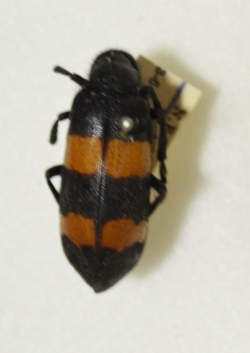 Blister Beetle from Rhodesia
Blister Beetle from Rhodesia
 Blister Beetle from Rhodesia
Blister Beetle from Rhodesia Many animals were (and still are) killed for medicinal reasons. Blister beetles are so-called because they give off a toxin which causes blistering if rubbed on the skin. In concentrated form, this chemical (called cantharidin) has been used as a poison, an aphrodisiac and a treatment for smallpox. As late as 1941, the colonial entomologist W V Harris recommended the use of African child labour for large-scale harvesting of blister beetles.
This beetle was collected in 1910 at Fort Jamieson, the capital of what was then called North-Eastern Rhodesia (now part of Zambia). It was then a British Protectorate run by a private enterprise, the British South Africa Company, until 1924 when the British Government took it over. Rhodesia was named by white settlers after Cecil Rhodes, the empire-builder who founded the company, while Fort Jamieson was after his Scottish Lieutenant, Leander Starr Jamieson. By a combination of force and deceitful negotiations with tribal chiefs, the company gained control of large areas of South- Central Africa.
Image right: Blister Beetle
Echidna from Australia
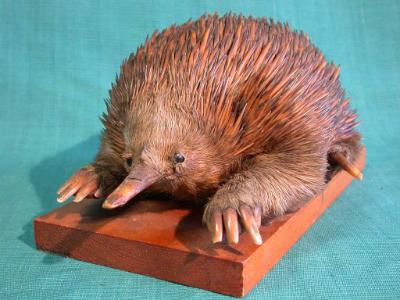 Echidnas tell different stories of colonisation. Like most specimens on display in UK museums, this is a short-beaked echnida. It came from Australia after its colonisation by the British. Long-beaked echidnas are more common in German and Dutch museums, as New Guinea, where the species lives, was largely colonised by those countries.
Echidnas tell different stories of colonisation. Like most specimens on display in UK museums, this is a short-beaked echnida. It came from Australia after its colonisation by the British. Long-beaked echidnas are more common in German and Dutch museums, as New Guinea, where the species lives, was largely colonised by those countries.
Australian animals are often poorly represented by museum specimens. This echidna has been made to look comical, with its feet splayed outwards and its belly on the ground. In life, echidnas stand up off the ground with their feet forwards. Echidna, like platypuses, are often misrepresented and described as weird or wonderful curiosities. Such descriptions are rooted in colonialist perceptions in which Western animals act as the zoological standard.
Image left: Echidna
Visit the museum to find out many more fascinating stories...